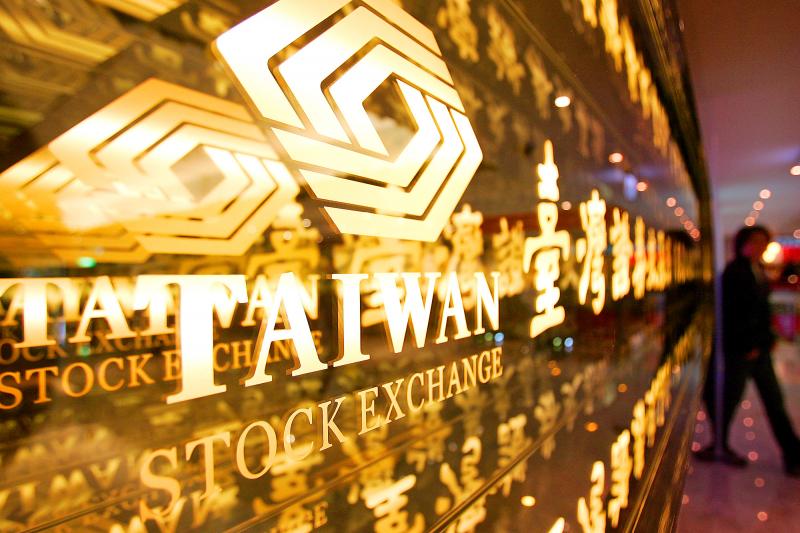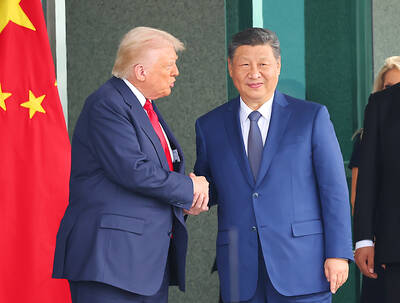The aggregate revenue of companies listed on the Taiwan Stock Exchange (TWSE) grew at a much slower pace last month, as financial companies’ investments were affected by the Russia-Ukraine war and optoelectronics companies saw falling demand, the exchange’s data showed.
The combined revenue of the 963 TWSE-listed firms edged up 1.66 percent from a year earlier to NT$3.11 trillion (US$104.7 billion), after growing 14 percent in March, the data showed.
The TWSE said that 507 companies, or 52.6 percent, reported revenue growth, while 456 companies posted declines.

Photo: Maurice Tsai, Bloomberg
The financial sector saw revenue fall by NT$52.8 billion, or 23.61 percent, annually to NT$170.8 billion last month, affected by market volatility and the Russia-Ukraine war, the exchange said.
It was the fourth consecutive month that the financial sector posted a decline, but last month’s fall narrowed from March’s NT$103.3 billion, it said.
For the first four months of the year, the financial sector’s revenue decreased by NT$156.1 billion, or 16 percent, to NT$799.8 billion, TWSE data showed.
The optoelectronics sector reported the largest fall in revenue last month, down 24.06 percent year-on-year to NT$94.7 billion, as flat-panel prices dropped and demand weakened, the exchange said.
LCD panelmakers Innolux Corp (群創) and AU Optronics Corp (AUO, 友達光電) reported that revenue declined 13.8 percent and 31 percent respectively last month, while smartphone camera lens maker Largan Precision Co (大立光) saw revenue contract 7.6 percent, companies’ data showed.
For the first four months, the optoelectronics sector reported that cumulative revenue dipped 8 percent to NT$434.7 billion, TWSE data showed.
The shipping sector’s revenue continued to rise last month on the back of higher freight rates, with sales advancing 60 percent to NT$158.5 billion, the exchange said.
The sector’s cumulative revenue in the first four months expanded 68 percent to NT$639.1 billion, it said.
The semiconductor sector, as well as the oil, gas and electricity sector, also continued to post strong revenue growth last month, the exchange said.
From January to last month, TWSE-listed firms’ aggregate revenue rose 9.89 percent from a year earlier to NT$12.9 trillion, TWSE data showed.

RUN IT BACK: A succesful first project working with hyperscalers to design chips encouraged MediaTek to start a second project, aiming to hit stride in 2028 MediaTek Inc (聯發科), the world’s biggest smartphone chip supplier, yesterday said it is engaging a second hyperscaler to help design artificial intelligence (AI) accelerators used in data centers following a similar project expected to generate revenue streams soon. The first AI accelerator project is to bring in US$1 billion revenue next year and several billion US dollars more in 2027, MediaTek chief executive officer Rick Tsai (蔡力行) told a virtual investor conference yesterday. The second AI accelerator project is expected to contribute to revenue beginning in 2028, Tsai said. MediaTek yesterday raised its revenue forecast for the global AI accelerator used

TEMPORARY TRUCE: China has made concessions to ease rare earth trade controls, among others, while Washington holds fire on a 100% tariff on all Chinese goods China is effectively suspending implementation of additional export controls on rare earth metals and terminating investigations targeting US companies in the semiconductor supply chain, the White House announced. The White House on Saturday issued a fact sheet outlining some details of the trade pact agreed to earlier in the week by US President Donald Trump and Chinese President Xi Jinping (習近平) that aimed to ease tensions between the world’s two largest economies. Under the deal, China is to issue general licenses valid for exports of rare earths, gallium, germanium, antimony and graphite “for the benefit of US end users and their suppliers

Dutch chipmaker Nexperia BV’s China unit yesterday said that it had established sufficient inventories of finished goods and works-in-progress, and that its supply chain remained secure and stable after its parent halted wafer supplies. The Dutch company suspended supplies of wafers to its Chinese assembly plant a week ago, calling it “a direct consequence of the local management’s recent failure to comply with the agreed contractual payment terms,” Reuters reported on Friday last week. Its China unit called Nexperia’s suspension “unilateral” and “extremely irresponsible,” adding that the Dutch parent’s claim about contractual payment was “misleading and highly deceptive,” according to a statement

The Chinese government has issued guidance requiring new data center projects that have received any state funds to only use domestically made artificial intelligence (AI) chips, two sources familiar with the matter told Reuters. In recent weeks, Chinese regulatory authorities have ordered such data centers that are less than 30 percent complete to remove all installed foreign chips, or cancel plans to purchase them, while projects in a more advanced stage would be decided on a case-by-case basis, the sources said. The move could represent one of China’s most aggressive steps yet to eliminate foreign technology from its critical infrastructure amid a